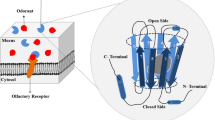Abstract
Olfactory perception is the sense of smell that allows an organism to detect chemical in its environment. The first step in odor transduction is mediated by binding odorants to olfactory receptors (ORs) which belong to the heptahelical G-protein-coupled receptor (GPCR) super-family. Mammalian ORs are disposed in clusters on virtually all chromosomes. They are encoded by the largest multigene family (\(\sim \)1000 members) in the genome of mammals and Caenorhabditis elegans, whereas Drosophila contains only 60 genes. Each OR specifically recognizes a set of odorous molecules that share common molecular features. However, local mutations affect the DNA sequences of these receptors. Hence, to study the changes among affected and non-affected, we use unsupervised learning (clustering). In this paper, a scaled fuzzy graph model for clustering has been used to study the changes before and after the local mutation on DNA sequences of ORs. At the fractional dimensional level, our experimental study confirms its accuracy.
Access this chapter
Tax calculation will be finalised at checkout
Purchases are for personal use only
Similar content being viewed by others
References
Rosenfeld, A.: Fuzzy graphs. In: Zadeh, L.A., Fu, K.S., Shimura, M. (eds.), Fuzzy Sets and Their Applications to Cognitive and Decision Processes, Academic Press, New York, pp. 77–95(1975).
Zadeh, L.A.: Fuzzy sets. Inform. Control 8, 338–353 (1965)
Yeh R.T., Bang S.Y., Fuzzy relations, Fuzzy relations, fuzzy graphs and their applications to clustering analysis. In: Zadeh L.A., Fu K.S., Shimura M. (eds.), Fuzzy Sets and Their Applications, Academic Press, pp. 125–149(1975).
Mathew, S., Sunitha, M.S.: Node connectivity and arc connectivity of a fuzzy graph. Inform. Sci. 180, 519–531 (2010)
Bhattacharya, P.: Some remarks on fuzzy graphs. Pattern Recogn. Lett. 6, 297–302 (1987)
Bhattacharya, P., Suraweera, F.: An algorithm to compute the maxmin powers and a property of fuzzy graphs. Pattern Recogn. Lett. 12, 413–420 (1991)
Mordeson, J.N.: Nair. Fuzzy graphs and fuzzy hypergraphs. Physica-Verlag, P.S. (2000)
Diday, E., Simon, J.C.: Clustering analysis. In: Fu, K.S. (ed.) Digital Pattern Recognition, pp. 47–94. NJ, Springer-Verlag, Secaucus (1976)
Olfactory Receptors Database. http://senselab.med.yale.edu/ordb/
DNA to protein translation. http://insilico.ehu.es/translate/
Protein Structure Prediction Server. http://ps2.life.nctu.edu.tw/index.php
Gaillard, I., Rauquier, S., Giorgi, D.: Olfactory Receptors. ICMLS Cell. Mol. Life Sci. 61, 456–469 (2004)
Author information
Authors and Affiliations
Corresponding author
Editor information
Editors and Affiliations
Rights and permissions
Copyright information
© 2014 Springer India
About this paper
Cite this paper
Dash, S.R., Dehuri, S., Sahoo, U.K., Wang, G.N. (2014). On Clustering of DNA Sequence of Olfactory Receptors Using Scaled Fuzzy Graph Model. In: Babu, B., et al. Proceedings of the Second International Conference on Soft Computing for Problem Solving (SocProS 2012), December 28-30, 2012. Advances in Intelligent Systems and Computing, vol 236. Springer, New Delhi. https://doi.org/10.1007/978-81-322-1602-5_93
Download citation
DOI: https://doi.org/10.1007/978-81-322-1602-5_93
Published:
Publisher Name: Springer, New Delhi
Print ISBN: 978-81-322-1601-8
Online ISBN: 978-81-322-1602-5
eBook Packages: EngineeringEngineering (R0)




